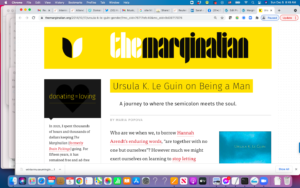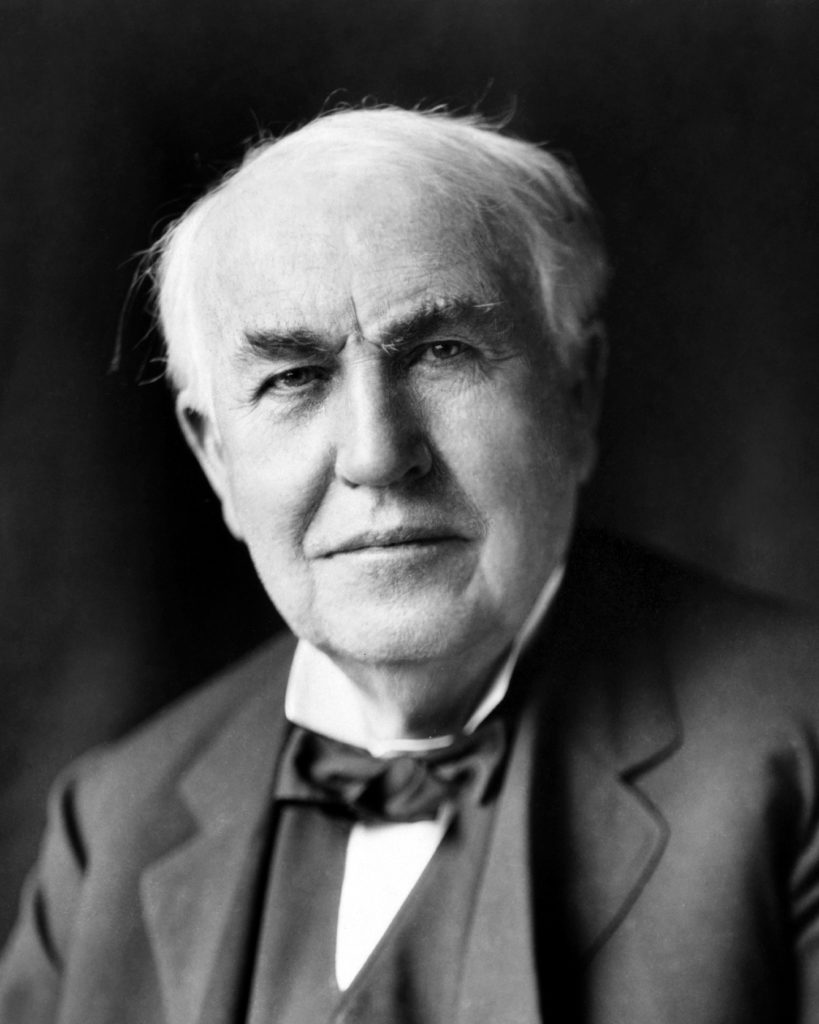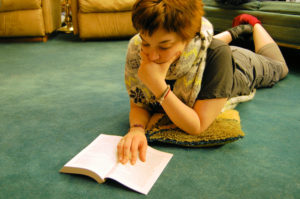Maria Popova Keeps My Heart Open to the World


I read Seth Godin’s daily blog almost daily but I missed this one from a couple of days ago. I think he’s absolutely right. Kids need time in nature, to daydream, to make friends, and do things that don’t involve a screen.
And they need to develop independence. It’s a myth that you can protect your kid from all bad or even uncomfortable things. And some discomfort is necessary to growth. Otherwise, when they do hit a challenge, they are completely unable to cope. I believe in parenting that presents gradual increases in challenges. That doesn’t mean forcing kids to do things where they have zero interest or skill, but helping them find the places where growth is exciting, and helping them get through the uncomfortable incidents in their lives–but not by attempting to seal them off in a vacuum tube somewhere.
Then there’s the effect on our biology. I know from paying careful attention to my own body that I’m most comfortable if my on-screen shifts are an hour or less. Research confirms that prolonged computer use creates health problems (one of 369,000,000 results for “health effects of computer use”, BTW).
Electronic babysitters are not really new, just intensified. In my day, many of my peers were shuttled off to the family television, nicknamed, for good reason, the “boob tube.” Mainstream TV in the 1960s, and especially kid programming in the pre-Sesame Street, pre-Mr. Rogers days, sabotaged intelligence and reinforced a culture of violence. Even the years-later and scrupulously politically correct Barney worked really hard to dumb things down, and that was public TV–while Sesame Street, although a terrific show, changed our thought patterns and shortened our attention spans by chopping up several stories into little pieces and scattering them throughout the show.
Luckily, my mom believed in limiting TV. We were allowed two hours a day, after completing our homework, and nothing too violent. I am very grateful to her for this rule, and to my first grade teacher who recognized that Sally, Dick, and Jane bored me–I was reading at age three–and sat me down in the back of the room with a 4th-grade geography book. Under these two influences, I became an avid reader. From then on, any time I felt bored, I could escape into a book. I discovered a world of ideas (and their potential to create a more just, eco-friendly world) in biography, science, and “think” books…alternate worlds in science fiction…wonderful characters in literary fiction…deductive reasoning combining with intuitive leaps in detective novels. I always say I became a writer because I’m interested in everything–but being a reader created that interest. Oh, and I still find geography fascinating.
My interest in reading predates school. I still remember being frustrated because the New York Public Library wouldn’t let me get a library card until I could write my name, which only happened two or three years after I was reading. My mom had to use some of her precious allotment to keep me in reading material. Years later, when NYPL lifted the 6-books-at-a-time limit, my mom would take a shopping cart over to her branch, fill it up, read the books on her 3 hours of bus commuting per day, and trade them in two weeks later for another batch. I started tracking the number of books I’m reading a few years ago, and it’s ranged from 83 to 88 per year. This year, it will probably be more like 75, because an all-consuming family situation cut deeply into my reading time this fall. It’s at 71 as of today. And reading is eco-friendly and frugal (thank you, public libraries and friends with interesting books), too.
We read Charlotte’s Web to our daughter when she was four. At seven, it was the first full-length chapter book she read on her own. A few years later, she got to play Charlotte in a local theater production. In college, she did a long academic paper on the deeper philosophical implications of

Phillip Pullman’s His Dark Materials trilogy. Now she’s about to get a master’s degree in teaching adult literacy.
Today, at least, screen time is much more interactive. Instead of sitting passively, kids create scenarios and alternative endings, share their discoveries on social media, etc. But they do it in nanobits.
But in today’s electronic world, I worry about attention span, focus, creativity–and empathy; I see a rapidly growing culture of intolerance (125,000,000 results on Google for “social media bullying”). In a world with no attention span, how can we make the next lightbulb discovery? Edison himself described inventing the lightbulb as a 10,000-step process. Nanobits don’t lead down that torturous path. Reading, meanwhile, reinforces attention span, focus, and creativity. Whether it narrows or widens your horizons depends on what you choose to read.
And reading can also be interactive, because you create your own storylines and then read further to see if you’re right.
What if your kid has learning disabilities or other issues that make reading difficult? Try audiobooks, or make the time to read aloud, or bring the books down a couple of grade levels until your child is ready for more. Or substitute other equally creative activities, from one-sentence-per-person storytelling to counting how many ideas you can get on a stroll through a forest. Even kids who love to read can benefit by broadening their creative repertoire.
My mom told me often that I taught myself to read at age 3 by sounding out stuff on cereal boxes, mayonnaise jars, etc. And to this day, I read packaging, ads, tracts…whatever is lying around. She also told me that I was extremely frustrated that I couldn’t get a New York Public Library (NYPL) card until I could write my name, which took another two years after I learned to read. She had to take books out for me on her card. I have no memory of either of these things. But I do remember that I was reading fluently by the beginning of first grade. At age 60, I’m still grateful to my first grade teacher, who sat me in the back of the room with a 4th grade geography textbook while she inflicted Sally, Dick, and Jane on the rest of the class (and I still love geography).

Much later, I met my wife, novelist and poet D. Dina Friedman, at a poetry reading in Greenwich Village
I was skeptical of Mom’s claims about me until we discovered when my son was 2 and some months that he could tell words like wax, fax, and max apart, visually, because my daughter had sat him down and taught him. He was not an early reader but obviously could have been if it had been a priority. He was (and still is at 25) focused on music. We started reading to our kids when they were infants. My daughter, gluten-free/vegetarian gourmet food blogger Alana Horowitz Friedman and her husband are both avid readers, too.
Mom was like that too. Once they lifted the old limit of eight books at a time, she would go to the local NYPL branch every two weeks with a SHOPPING CART, fill it with books, and wheel it the mile back to our house. She had a long commute to Manhattan via express bus and that’s where she did much of her reading.
I’m still a voracious reader. Books have opened up my mind to such incredible richness of thought and emotion. Much of my thinking on everything from nonviolent social change to green business success comes from processing and extrapolating on what I read to come up with something new. The world is a much more interesting place to me because of writers like Dave Dellinger, Gandhi, and Gene Sharp’s writings about nonviolence, and Amory Lovins, Janine Benyus, and William McDonough on the green business side.
But a few years ago, I realized that while I made time in my busy life for nonfiction, I didn’t do enough pleasure reading. I started making sure I read at least five minutes a day of a book that had nothing to do with work.
Of course, five minutes was nowhere near enough if I was into a good book. I found all sorts of nooks and crannies in my day to read. And then I decided to get a lot more exercise. Much of that is on an indoor stationary bicycle: a perfect place to read! Typically, I start my first shift of the day with a poem, then ten minutes of nonfiction and ten minutes of fiction or memoir. If I’m biking 20 minutes, that’s my whole shift. If (more typically) I’m doing 30 minutes, I often spend the remaining 10 checking Facebook from my phone, because I have to make time in my life for social media, too.
With most of it on the exercise bike, I’m actually reading more than 80 books a year!
Some vast number of people never read another book after college. They’re cheating themselves. Make time in your own life for this great pleasure!